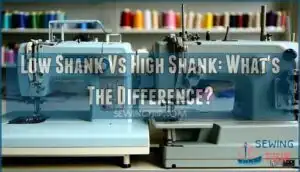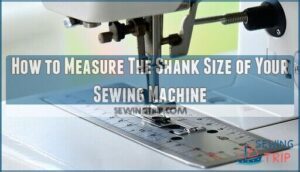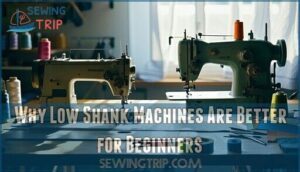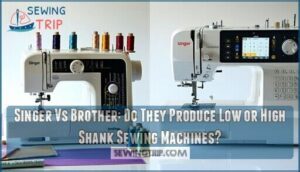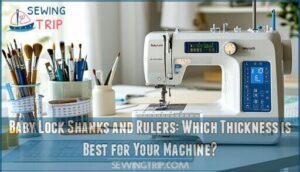This site is supported by our readers. We may earn a commission, at no cost to you, if you purchase through links.
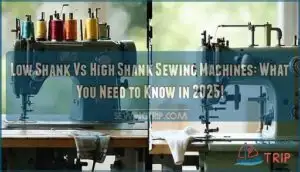 The difference between low shank and high shank sewing machines is in the metal bar that holds your presser foot.
The difference between low shank and high shank sewing machines is in the metal bar that holds your presser foot.
Low shank machines have a 1/2-inch distance from the screw hole to the bottom, while high shanks measure about 1 inch.
This determines which presser feet and attachments you can use with your machine.
Most home sewing machines are low shank (like many Singer and Brother models), while high shank designs appear in industrial and higher-end machines.
You can’t interchange these parts without adapters.
Knowing your machine’s shank type saves you from purchasing incompatible accessories and opens up possibilities for specialized sewing techniques.
Table Of Contents
- Key Takeaways
- Low Shank Vs High Shank: What’s The Difference?
- Understanding Presser Feet for Low and High Shank Machines
- Efficiency: Which Shank Size is Best for Your Sewing Project?
- How to Measure The Shank Size of Your Sewing Machine
- Why Low Shank Machines Are Better for Beginners
- Singer Vs Brother: Do They Produce Low or High Shank Sewing Machines?
- Baby Lock Shanks and Rulers: Which Thickness is Best for Your Machine?
- Frequently Asked Questions (FAQs)
- Conclusion
Key Takeaways
- You’ll need to know your machine’s shank type (the distance from screw hole to bottom) before buying accessories—low shanks measure about 1/2 inch while high shanks measure about 1 inch.
- You’re likely using a low shank machine if you own a typical home sewing model like most Singer or Brother machines, while high shank designs appear in industrial and higher-end equipment.
- You can use adapters to make presser feet work between different shank types, saving you from purchasing completely new accessories when switching machines.
- You’ll find low shank machines more beginner-friendly and budget-conscious with widely available accessories, while high shank machines offer better clearance for thick fabrics and specialized techniques.
Low Shank Vs High Shank: What’s The Difference?
You’ll find that low shank sewing machines have a shorter metal rod (about 1/2 inch) connecting the presser foot to the machine.
While high shank machines feature a longer rod (about 1 inch or more), this difference affects which presser feet you can use and what projects your machine handles best.
Low shank models are typically found in home sewing machines and high shank versions in more industrial or heavy-duty equipment.
Purpose
The primary purpose of shank size relates directly to your sewing machine’s intended use.
When choosing between low and high shank machines, understanding their distinct purposes can save you time and frustration.
| Feature | Low Shank | High Shank | Best For |
|---|---|---|---|
| Intended Use | Home sewing | Industrial work | Depends on project |
| Fabric Thickness | Light to medium | Heavy, multiple layers | Based on sewing skill |
| Clearance | Less space | More room | Match to material |
| Project Versatility | Everyday tasks | Specialized projects | Your specific needs |
Low shank machines excel at common household projects, making them perfect for beginners.
High shank designs provide extra clearance for bulky fabrics and industrial applications.
Your choice should align with your typical projects—don’t buy industrial power when simple home sewing is your goal.
It is essential to consider the intended use and match it with the machine’s capabilities to ensure the best results.
Length
The key distinction between low and high shank machines is their length measurement. After understanding their purpose, you’ll need to know exactly how these heights differ.
The following table outlines the main differences between low and high shank machines:
| Feature | Low Shank | High Shank |
|---|---|---|
| Shank Height | ½ inch or less | 1 inch or more |
| Needle Clearance | Limited | Generous |
| Fabric Thickness | Standard | Heavy-duty |
| Sewing Precision | Good for everyday | Enhanced for thick materials |
| Measurement Method | Screw to plate | Screw to plate |
Measuring your machine’s shank size involves checking the distance from the screw hole’s center to the stitch plate. This measurement accuracy determines which presser feet will fit your machine. Remember, shank length affects your ability to handle various fabric thicknesses without compromising sewing precision.
Shank size matters—measure accurately to ensure perfect presser foot fit and maintain sewing precision for every project.
Cost
Cost differences between low and high shank machines reflect their intended purpose in the sewing world.
You’ll typically find high shank models carrying a steeper price tag due to their industrial-grade capabilities and durability.
Low shank machines offer more budget-friendly options for home sewers while still delivering quality results.
| Machine Type | Initial Cost | Accessory Pricing |
|---|---|---|
| Low Shank | $150-$800 | More affordable |
| High Shank | $600-$3000+ | Premium pricing |
| Combination | $500-$1000 | Varies by brand |
| Industrial | $1000-$5000 | Specialized |
| Vintage | $50-$300 | Limited availability |
When considering long-term value, factor in repair costs and accessory compatibility with your shank height before investing in a machine that meets your sewing needs.
Understanding Presser Feet for Low and High Shank Machines
After learning about shank differences, let’s talk about those handy presser feet.
Your machine’s shank size directly impacts foot compatibility.
Low shank machines (measuring under 3/4 inch) work with a wide range of presser feet for everyday sewing.
High shank machines (measuring 1+ inch) typically offer better stitch quality for heavier fabrics.
Don’t worry if you have the "wrong" feet—adapters let you use specialty feet designed for either type.
A presser foot adapter can solve compatibility issues.
The adapter usage is straightforward: snap it on and you’re ready to sew.
Just remember that foot pressure might need adjusting when switching between adapter types.
Efficiency: Which Shank Size is Best for Your Sewing Project?
When choosing between shank sizes, consider your project complexity first.
Low shank machines work best for everyday sewing projects with lighter fabrics and simple attachment needs.
They’re faster for beginners and offer plenty of versatility.
High shank machines excel with thicker fabrics and complex tasks that require repeated heavy-duty stitching.
The extra clearance they provide makes handling bulky quilts or multiple layers much easier.
Your sewing machine’s shank size should match your typical projects—don’t use a low shank for industrial-grade tasks or a high shank for delicate work.
Many accessories are available for machines using low shanks.
How to Measure The Shank Size of Your Sewing Machine
Now that you know which shank size works for different projects, let’s figure out how to measure your sewing machine’s shank. This isn’t complicated once you know the right approach.
Here’s how to determine your machine’s shank size:
- Remove the presser foot from your machine to expose the metal rod (shank).
- Get a ruler with clear measurement units (preferably in inches).
- Measure from the center of the screw hole to the stitch plate – this is your shank measurement.
- Compare your results: low shank measures 1/2 inch or less; high shank is 1 inch or more.
Accurate tools make this process straightforward. You can find products here to help with measuring. Remember, knowing your sewing machine’s shank size prevents frustration when purchasing presser feet or attachments, and check adapter needs based on your measurement if you want to use feet designed for a different shank type.
Why Low Shank Machines Are Better for Beginners
While experienced sewists might choose either type, low shank machines offer clear advantages for beginners entering the sewing world.
You’ll find these domestic machines more approachable in several key ways.
| Feature | Low Shank | High Shank |
|---|---|---|
| Affordability | More budget-friendly | Generally costlier |
| Versatility | Excellent for most projects | Specialized capabilities |
| Learning curve | Gentler, more forgiving | Steeper, more complex |
| Project suitability | Perfect for everyday sewing | Better for industrial work |
The ease of use makes low shank machines ideal for beginners.
Their versatility accommodates various projects while you develop skills without overwhelming complexity or expense.
The fact that they are more budget-friendly and have a gentler learning curve makes them a great choice for those new to sewing.
Singer Vs Brother: Do They Produce Low or High Shank Sewing Machines?
When shopping for a sewing machine, understanding Singer and Brother’s shank offerings will save you headaches later. Both brands primarily produce low shank machines for home use, with select high shank models for specialized work.
| Feature | Singer | Brother |
|---|---|---|
| Main shank type | Low shank | Low shank |
| High shank models | Limited, mostly industrial | Models 1300, 1500 series |
| Unique variations | Slant shank (older models) | None significant |
| Compatibility | Works with most accessories | Can be finicky with non-Brother parts |
| Overall quality | Declining in newer models | More reliable, beginner-friendly |
If you’re using Singer or Brother, check your model’s specifications before buying accessories – shank adapter usage might be necessary for cross-compatibility. Many Brother models feature user-friendly low shanks ideal for beginners.
Baby Lock Shanks and Rulers: Which Thickness is Best for Your Machine?
While Singer and Brother primarily offer low shank machines, Baby Lock provides ruler options for both machine types.
Baby Lock’s rulers come in specific thicknesses matched to your machine’s shank size. Low shank rulers are 1/8" thick and work perfectly with low shank machines, while high shank rulers measure 1/4" thick for high shank and long arm machines.
Your ruler foot should float just above the fabric surface for ideal ruler usage. The Baby Lock ruler echo foot 5-piece set includes specialty quilting feet and a ruler kit designed with precise measurements from needle to edge, ensuring shank ruler precision every time.
Frequently Asked Questions (FAQs)
Are Singer sewing machines high or low shank?
Contrary to popular belief, most household Singer machines feature a low shank design.
You’ll find this standard configuration on nearly all domestic models, while industrial Singers typically use high shank.
Some vintage models (1960-70s) use slant shank instead.
What is a low shank sewing machine used for?
Low shank sewing machines are perfect for your home projects and everyday sewing tasks.
They’re flexible enough to handle various fabrics while being more affordable and accessible than their high shank industrial counterparts.
How do quilters use rulers for their projects?
You’d think rulers are just for measuring, wouldn’t you?
But in quilting, you’ll use specially designed rulers with your machine to create precise straight lines, curves, and patterns while free-motion quilting.
Can adapters work between different shank types?
Yes, adapters can bridge the gap between different shank types.
You’ll find low-to-high and high-to-low adapters available that let you use presser feet designed for one shank type on machines with another type.
Are slant shanks different from low/high shanks?
You’d be surprised – slant shanks are indeed different.
They’re angled at about 80 degrees rather than straight up like low or high shanks, requiring their own specific presser feet and adapters.
Which industrial machines use high shanks?
Most industrial sewing machines use high shanks, including brands like Juki, Consew, and Singer industrial models.
You’ll find them in garment factories, upholstery shops, and professional tailoring businesses where heavy-duty work is common.
Do vintage machines follow modern shank standards?
Like timeless heirlooms with their own personalities, vintage machines often dance to their own tune.
You’ll find many don’t conform to modern low or high shank standards, requiring specific adapters for current accessories.
How do shank types affect quilting performance?
High shank machines offer more clearance for quilting rulers and thicker quilts.
You’ll find it easier to see your work and manage bulky projects, while low shank machines require special adapters for quilting accessories.
Conclusion
Whether you’re rocking a low shank or high shank sewing machine, understanding this critical difference saves time and money on accessories.
Your machine’s shank type determines which presser feet you can use without adapters.
Most beginners benefit from low shank machines due to wider availability of affordable attachments, while experienced sewists might prefer high shank models for specialized techniques.
Check your measurements before purchasing, and you’ll be well on your way to expanding your low shank vs high shank sewing machine capabilities!

